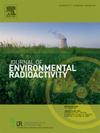Bentonite-goethite composite Colloids: Unraveling the mechanisms of strontium adsorption inhibition in claystone for nuclear waste geologic repositories
IF 2.1
3区 环境科学与生态学
Q3 ENVIRONMENTAL SCIENCES
引用次数: 0
Abstract
The management and disposal of radioactive waste, especially strontium (Sr), is a critical aspect of sustainable nuclear energy utilization. This study examines the adsorption of Sr onto the surrounding rock of a high-radioactivity geological repository, with a specific emphasis on the Suhongtu claystone and its interaction with bentonite‒goethite composite colloids. By utilizing a sequence of static adsorption experiments, adsorption kinetic models, and diverse spectroscopic methods, this research aims to shed light on the adsorption mechanism of Sr influenced by these composite colloids. These results indicate that the claystone adsorption capacity for Sr is considerably affected by pH and that the adsorption rates are elevated in alkaline environments. The bentonite–goethite composite colloid formed a protective layer on the surface of the plagioclase in the claystone, hindering ion exchange between the strontium and the surface of the plagioclase and thus inhibiting strontium adsorption by the claystone. This study offers profound insights into the function of composite colloids in the adsorption process and has potential implications for the design and safety evaluation of radioactive waste repositories.
膨润土-针铁矿复合胶体:揭示核废料地质储存库粘土岩中锶吸附抑制机制
放射性废物,特别是锶的管理和处置是可持续利用核能的一个关键方面。本文研究了Sr在高放射性地质库围岩上的吸附,重点研究了苏红图粘土岩及其与膨润土-针铁矿复合胶体的相互作用。通过一系列的静态吸附实验、吸附动力学模型和多种光谱方法,本研究旨在揭示这些复合胶体对锶的吸附机理。结果表明,黏土石对锶的吸附能力受pH的影响较大,在碱性环境中吸附速率提高。膨润土-针铁矿复合胶体在粘土岩中斜长石表面形成保护层,阻碍了锶与斜长石表面的离子交换,从而抑制了粘土岩对锶的吸附。该研究为复合胶体在吸附过程中的作用提供了深刻的见解,并对放射性废物处置库的设计和安全性评价具有潜在的指导意义。
本文章由计算机程序翻译,如有差异,请以英文原文为准。
求助全文
约1分钟内获得全文
求助全文
来源期刊

Journal of environmental radioactivity
环境科学-环境科学
CiteScore
4.70
自引率
13.00%
发文量
209
审稿时长
73 days
期刊介绍:
The Journal of Environmental Radioactivity provides a coherent international forum for publication of original research or review papers on any aspect of the occurrence of radioactivity in natural systems.
Relevant subject areas range from applications of environmental radionuclides as mechanistic or timescale tracers of natural processes to assessments of the radioecological or radiological effects of ambient radioactivity. Papers deal with naturally occurring nuclides or with those created and released by man through nuclear weapons manufacture and testing, energy production, fuel-cycle technology, etc. Reports on radioactivity in the oceans, sediments, rivers, lakes, groundwaters, soils, atmosphere and all divisions of the biosphere are welcomed, but these should not simply be of a monitoring nature unless the data are particularly innovative.
 求助内容:
求助内容: 应助结果提醒方式:
应助结果提醒方式:


